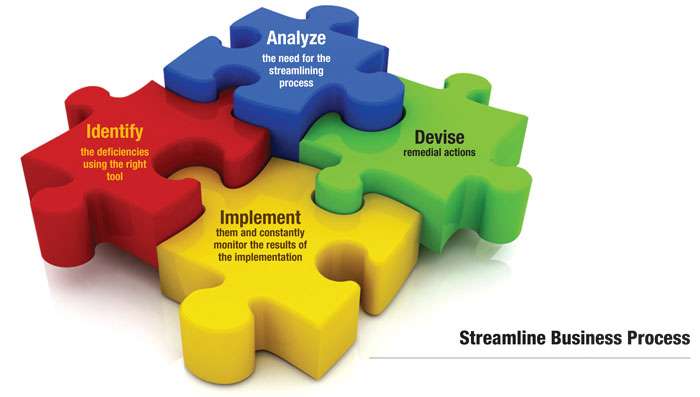The four things you should do to streamline your business process are – analyze the need for the streamlining process, identify the deficiencies using the right tool, devise remedial actions and implement them and constantly monitor the results of the implementation.
--By Harendra Jung Thapa
Businesses have their own nitty-gritties, policies, regulations, working culture, IT platform and work flow processes to suit the flavour of their business model. As a manager or a unit head in your organization, it is on you to ensure your unit’s end to end business process is flawless and seamless. However, at times, the process may seem to lack the ingredients that go into perfection. It results in the disruption of the flow-process thus creating an unprecedented situation of embarrassment or chaos. It is here where your knowledge of TQM’s (Total Quality Management) integral and significant streamlining business process comes to be a handy tool to revamp the procedural mechanism and process lags.
The streamlining involves weeding out irrelevant, low value oriented, unpractical, or duplicated portions of the work flow process. The four things you should do to streamline your business process are – analyze the need for the streamlining process, identify the deficiencies using the right tool, devise remedial actions and implement them and constantly monitor the results of the implementation.
Analyzing the Need for Streamlining
With time, any process may not work absolutely well. You have to review the processes at certain time intervals and according to the arising need, streamline the process for standardization with an innovative approach. You may now ask, how do you know when it’s the right time for streamlining the business process. Obviously, if there are intermittent obstacles in the business process which are of a recurring nature, then that is the time when you should intervene. You should check whether your business process has one or more of the following characteristics-
- Existence of meandering work processes
- Duplication of certain tasks
- Long approval processes
- Detailed documentation more than the information demanded
- Bureaucratic practices heavily dominant
- Frequent customer complaints of grave nature
- Unskilled or untrained human resources
- Unexpectedly long Service/production turn-around time
If your business process exhibits one or more of the above mentioned characteristics, then the alarm bells should start ringing telling you that it is time to jump start the streamlining process of your business. Leaving things as they are will impede the smooth flow of the work process and mar the efficiency, degrading the quality of service or pace of production.
Identifying Deficiencies with the Right Tool
To identify where the problem lies, you could use ICOR (inputs, constraints, outputs and resources) to do the process mapping. By doing so, you will break the whole process into a chain of multiple sub-processes and find linkages between different compartments of the process. You can then create a current process map and compare it with your future process map. It helps you to point out the deficiencies in the current process and eases your decision making to wipe out those deficiencies.
An alternative to process mapping would be process flow-charting. You will get to see the full diagram of the process flow when flow-charting the process. This will help you to understand the sequential flow of the sub-processes and identify the flaws like duplication, unnecessary part of the work process, problems and weaknesses.
Devising Remedial Actions and Implementation
Depending on the deficiencies to eliminate, you need to take appropriate corrective actions. If the process is too old or obsolete you should replace it with modern methods and technology. If there are duplications, you need to eliminate one. The process which involves a lot of work with documents also hinders the turn-around time. Hence, the requirement for paper work should be minimal in all cases. In this context, if it is possible, take approval from a senior worker to rightly amend the internal policy that requires the submission and scrutinizing of documents.
You should ensure that the employees under your command do have adequate knowledge and skills to perform their best in executing the business process. If the skills are lacking, train them. Yet another way to control the process lag is to delegate work. Apart from shortening the end to end process, it also saves your time to focus on your prioritized works for better achievements and induces the sense of trust and ownership in your subordinates. Those functions which are not the core functions of your department also happen to impede the pace of the core business process. In such a case do take up the matter with your seniors and opt for outsourcing such sub-processes which require great effort and time but yield very little or no value addition.
Constantly Monitor the Consequences of Implementation
Once you have rolled out the improvised processes, it is the time to monitor the impact it has on the overall process. You should have proper data recorded and analyzed to evaluate the impact. In case of negative consequences, you should correct it right away or put things on hold depending on the degree of impact. On the other hand, if there is positive impact then do allow it to remain a part of the business process. If the process is lengthy you can roll out your changes in phases. In any case you should be proactively reviewing your processes, with a readiness to align the processes, in line with the best possible standards.
The streamlining process in any industry ultimately benefits the customers. They enjoy the privilege of a short TAT (turn-around time)which in turn enhances customer satisfaction thus fostering customer loyalty and retention. As the streamlining leads to improvised changes, you may happen to inadvertently by pass the legal and regulatory aspects. Do make sure that you always keep in mind the legal and regulatory aspects while streamlining your business process.
The writer is a freelance writer/excel trainer &data consultant.





















